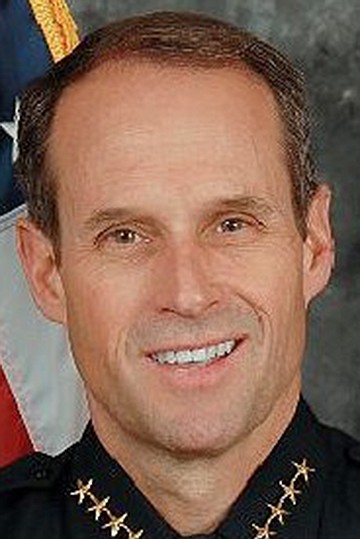 Facebook
Facebook
 X
X
 Instagram
Instagram
 TikTok
TikTok
 Youtube
Youtube
![“This [Vascular Neck Restraint] technique is derived from martial arts holds and is distinctly different from ‘choke holds’ [shown above] and other forms of neck compression or manipulation, which can restrict breathing or injure airway structures. A properly performed VNR does not apply pressure to the anterior neck, airway, or trachea and does not impair respiration.”](https://media.sandiegoreader.com/img/photos/2022/11/07/RADAR_Army_Combatives_RNC_wikpedia_t670.jpg?b3f6a5d7692ccc373d56e40cf708e3fa67d9af9d)
A paper from Wake Forest University’s Medical School, employing data on so-called Vascular Neck Restraint application by the San Diego Police Department, the North Carolina State Highway Patrol, and the Royal Canadian Mounted Police, argues that the controversial technique, despite its critics, is good to go. Gary M. Vilke, UCSD professor of emergency medicine, is listed as a co-author of the study.

“By banning [Vascular Neck Restraint], law enforcement officers have fewer options when taking a person into custody,” William P. Bozeman, M.D., professor of emergency medicine at the university, is quoted as saying in a November 2 university news release. “VNR is one of the least injurious tools that police have. And we now have evidence, for the first time, that it’s both safe and effective.”
Per Bozeman’s conclusions, published in the Journal of Forensic and Legal Medicine: “This technique applies pressure to the lateral neck vasculature and — if properly applied — may quickly produce either voluntary subject compliance or temporary unconsciousness.” Adds the study, “This technique is derived from martial arts holds and is distinctly different from ‘choke holds’ and other forms of neck compression or manipulation, which can restrict breathing or injure airway structures. A properly performed VNR does not apply pressure to the anterior neck, airway, or trachea and does not impair respiration.”
The difference between so-called chokeholds and vascular restraint has been the subject of past San Diego controversies. In October 2018, then-police chief David Nisleit promised to provide medical exams for those subjected to use of “carotid restraint” by the department, according to an October 28, 2018 Union-Tribune account, noting that chokeholds were already banned. “The chief explained that the key difference between the two neck restraints has to do with where pressure is applied. A chokehold puts pressure on the front of the neck and throat, cutting off air, while a carotid restraint targets the vascular veins on the side of the neck and cuts off blood to render someone unconscious ‘very, very quickly,’ Nisleit said.”
But the January 1992 death of 16-year-old John Hampton after an SDPD carotid hold had already prompted San Diego to limit the practice. “Although the carotid hold will not be abandoned, its use will be restricted to occasions in which a violent suspect must be rendered unconscious,” the Los Angeles Times reported on August 18, 1992. “Even then, it cannot be applied for longer than 30 seconds and should be used with at least two officers present.” Complained then-chief of police Bob Burgreen:
““Let’s be real, if you take that tool away, what does an officer have left? Would you rather be rendered unconscious...or have an officer come at you with a (baton) and beat you until your bones break? In a real-world situation, those are the options and those are the only options.”

Critics of the practice, including Alara Chilton, then-immediate past president of the San Diego La Raza Lawyers Association, remained unplacated. “The challenge is that when a person is met with this kind of (restraint), that person becomes (too) difficult to (have it) applied safely,” Chilton was quoted by the U-T as saying in 2018. “It is our position that you cannot apply it safely, because that person would be moving, and it would be verydifficult to reach the appropriate artery to safely cut off the circulation.” Chilton added that there had been “a lot of trauma and injury that results when this technique is applied.” Carotid restraints were finally banned altogether by then-San Diego mayor Kevin Faulconer following the May 25, 2020, death of George Floyd in custody of Minneapolis police. “We are watching the hurt and pain so many people are expressing after the tragic death of George Floyd,” said the mayor’s statement, as reported by a June 1, 2020, U-T dispatch, “and are committed to taking new actions to make sure something like this doesn’t happen in San Diego.”
The San Diego Union-Tribune, which lost Wendy Fry, its star Mexico beat reporter, to an online upstart two weeks ago, is advertising for a replacement. “This reporter should be able to tackle stories that make a difference and hold accountable institutions and people in power, while carefully navigating a complex reporting environment,” says a job notice for a new border reporter on LinkedIn.com. The new hire, per the writeup, will also be “providing impactful enterprise stories and daily news reports, primarily in English, for prominent display in print and on digital platforms,” as well as “pitching in on some weekend/holiday metro reporting shifts.”
Meanwhile, according to another LinkedIn job posting, the paper is also looking for a sports department chief. “The Sports Editor supervises the sports reporters and columnists, edits and publishes their digital work, collaborates with visual journalists, and works closely with three section and quality editors who produce our print sections,” says the notice. The new chief of sports is expected to “develop a strategy to prioritize digital development, grow readership and digital subscriptions.”
— Matt Potter
The Reader offers $25 for news tips published in this column. Call our voice mail at 619-235-3000, ext. 440, or sandiegoreader.com/staff/matt-potter/contact/.

![“This [Vascular Neck Restraint] technique is derived from martial arts holds and is distinctly different from ‘choke holds’ [shown above] and other forms of neck compression or manipulation, which can restrict breathing or injure airway structures. A properly performed VNR does not apply pressure to the anterior neck, airway, or trachea and does not impair respiration.”](https://media.sandiegoreader.com/img/photos/2022/11/07/RADAR_Army_Combatives_RNC_wikpedia_t670.jpg?b3f6a5d7692ccc373d56e40cf708e3fa67d9af9d)
A paper from Wake Forest University’s Medical School, employing data on so-called Vascular Neck Restraint application by the San Diego Police Department, the North Carolina State Highway Patrol, and the Royal Canadian Mounted Police, argues that the controversial technique, despite its critics, is good to go. Gary M. Vilke, UCSD professor of emergency medicine, is listed as a co-author of the study.

“By banning [Vascular Neck Restraint], law enforcement officers have fewer options when taking a person into custody,” William P. Bozeman, M.D., professor of emergency medicine at the university, is quoted as saying in a November 2 university news release. “VNR is one of the least injurious tools that police have. And we now have evidence, for the first time, that it’s both safe and effective.”
Per Bozeman’s conclusions, published in the Journal of Forensic and Legal Medicine: “This technique applies pressure to the lateral neck vasculature and — if properly applied — may quickly produce either voluntary subject compliance or temporary unconsciousness.” Adds the study, “This technique is derived from martial arts holds and is distinctly different from ‘choke holds’ and other forms of neck compression or manipulation, which can restrict breathing or injure airway structures. A properly performed VNR does not apply pressure to the anterior neck, airway, or trachea and does not impair respiration.”
The difference between so-called chokeholds and vascular restraint has been the subject of past San Diego controversies. In October 2018, then-police chief David Nisleit promised to provide medical exams for those subjected to use of “carotid restraint” by the department, according to an October 28, 2018 Union-Tribune account, noting that chokeholds were already banned. “The chief explained that the key difference between the two neck restraints has to do with where pressure is applied. A chokehold puts pressure on the front of the neck and throat, cutting off air, while a carotid restraint targets the vascular veins on the side of the neck and cuts off blood to render someone unconscious ‘very, very quickly,’ Nisleit said.”
But the January 1992 death of 16-year-old John Hampton after an SDPD carotid hold had already prompted San Diego to limit the practice. “Although the carotid hold will not be abandoned, its use will be restricted to occasions in which a violent suspect must be rendered unconscious,” the Los Angeles Times reported on August 18, 1992. “Even then, it cannot be applied for longer than 30 seconds and should be used with at least two officers present.” Complained then-chief of police Bob Burgreen:
““Let’s be real, if you take that tool away, what does an officer have left? Would you rather be rendered unconscious...or have an officer come at you with a (baton) and beat you until your bones break? In a real-world situation, those are the options and those are the only options.”

Critics of the practice, including Alara Chilton, then-immediate past president of the San Diego La Raza Lawyers Association, remained unplacated. “The challenge is that when a person is met with this kind of (restraint), that person becomes (too) difficult to (have it) applied safely,” Chilton was quoted by the U-T as saying in 2018. “It is our position that you cannot apply it safely, because that person would be moving, and it would be verydifficult to reach the appropriate artery to safely cut off the circulation.” Chilton added that there had been “a lot of trauma and injury that results when this technique is applied.” Carotid restraints were finally banned altogether by then-San Diego mayor Kevin Faulconer following the May 25, 2020, death of George Floyd in custody of Minneapolis police. “We are watching the hurt and pain so many people are expressing after the tragic death of George Floyd,” said the mayor’s statement, as reported by a June 1, 2020, U-T dispatch, “and are committed to taking new actions to make sure something like this doesn’t happen in San Diego.”
The San Diego Union-Tribune, which lost Wendy Fry, its star Mexico beat reporter, to an online upstart two weeks ago, is advertising for a replacement. “This reporter should be able to tackle stories that make a difference and hold accountable institutions and people in power, while carefully navigating a complex reporting environment,” says a job notice for a new border reporter on LinkedIn.com. The new hire, per the writeup, will also be “providing impactful enterprise stories and daily news reports, primarily in English, for prominent display in print and on digital platforms,” as well as “pitching in on some weekend/holiday metro reporting shifts.”
Meanwhile, according to another LinkedIn job posting, the paper is also looking for a sports department chief. “The Sports Editor supervises the sports reporters and columnists, edits and publishes their digital work, collaborates with visual journalists, and works closely with three section and quality editors who produce our print sections,” says the notice. The new chief of sports is expected to “develop a strategy to prioritize digital development, grow readership and digital subscriptions.”
— Matt Potter
The Reader offers $25 for news tips published in this column. Call our voice mail at 619-235-3000, ext. 440, or sandiegoreader.com/staff/matt-potter/contact/.
Comments